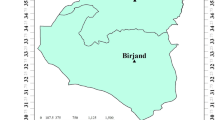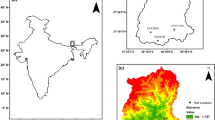Abstract
Wheat is an important dry season irrigated crop in the water-scarce Northwest Bangladesh. Knowledge on irrigation requirement of wheat under climate change is crucial for the planning of irrigated agriculture in the region. This study estimated irrigation requirement of wheat for Bogura, Rajshahi, Pabna, and Dinajpur districts for 2050s and 2080s under moderate (RCP4.5) and rapid (RCP8.5) climate change scenarios; RCP indicates representative concentration pathways. The climate scenarios were prepared from the outputs of five global circulation models (GCMs) with a combination of downscaling and bias correction. Reference crop evapotranspiration (ETo), effective rainfall (ER), potential crop-water requirement (∑ETC), and potential irrigation requirement (∑ETC–ER) were estimated by CropWat model. The ER, ∑ETC, and ∑ETC–ER were also determined for a base period of 1980–2013 for Bogura district to be used for comparison. The results reveal that ETo would increase during the wheat-growing period, with a greater increase during the development and mid-season stages and also under the rapid climate change compared to the moderate climate change scenario. Both the crop-water and irrigation requirement of wheat would increase due to increased ETo despite an increase in ER to some extent. The average irrigation requirement (over the climate models) would be 5.7% and 13.9% higher during 2050s and 2080s, respectively, compared to the base period under moderate climate change. The highest increase (17.5%) in irrigation requirement would be during 2080s under rapid climate change. The results of this study would be useful for local adaptation of irrigated agriculture to climate change.






Similar content being viewed by others
Data Availability
The data supporting this study’s findings are available on request from the corresponding author.
References
Mainuddin M, Pena-Arancibia JL, Karim F, Hasan MM, Mojid MA, Kirby JM (2022) Long-term spatio-temporal variability and trends in rainfall and temperature extremes and their potential risk to rice production in Bangladesh. PLOS Clim 1(3):1–33
Mojid MA (2020) Climate change-induced challenges to sustainable development in Bangladesh. IOP Conf Ser: Earth Environ Sci 423:012001. https://doi.org/10.1088/1755-1315/423/1/012001
Schellnhuber HJ, Hare B, Serdeczny O, Schaeffer M, Adams S, Baarsch F, Schwan S, Coumou D, Robinson A, Vieweg M, Piontek F (2013) Turn down the heat: climate extremes, regional impacts, and the case for resilience. Turn down heat Clim Extrem Reg impacts, case resilience. World Bank. https://doi.org/10.1596/978-1-4648-0055-9
Islam MS, Okubo K, Islam AHMS, Sato M (2022) Investigating the effect of climate change on food loss and food security in Bangladesh. SN Bus Econ 2. https://doi.org/10.1007/s43546-021-00177-z
IPCC (2014) Climate change 2014: the synthesis report of the fifth assessment report of the intergovernmental panel on climate change. Cambridge Univ Press Cambridge, UK
Agrawala S, Ota T, Ahmed AU, Smith JA, van Alast M (2003) Development and climate change in Bangladesh: focus on coastal flooding and the Sundarbans. Organ Econ Co-operation Dev., Paris, pp 1–70. http://www.oecd.org/env/cc/21055658.pdf
Shahid S (2010) Recent trends in the climate of Bangladesh. Clim Res 42:185–193. https://doi.org/10.3354/cr00889
Poulton PL, Rawson HM (2011) Physical constraints to cropping in southern Bangladesh. ACIAR Technical Reports No. 78. Australian Centre for International Agricultural Research, Canberra, pp 50–65
Uddin R, Islam M, Ullah M, Hore P, Paul S (2016) Grain growth and yield of wheat as influenced by variety and sowing date. Bangladesh Agron J 18:97–104. https://doi.org/10.3329/baj.v18i2.28911
Islam M, Kotani K, Managi S (2016) Climate perception and flood mitigation cooperation: a Bangladesh case study. Econ Anal Policy 49:117–133. https://doi.org/10.1016/j.eap.2016.01.001
Mondol MAH, Al-Mamun, Iqbal M, Jang DH (2018) Precipitation concentration in Bangladesh over different temporal periods. Adv Meteorol 2018. https://doi.org/10.1155/2018/1849050
Sarker MAR, Alam K, Gow J (2012) Exploring the relationship between climate change and rice yield in Bangladesh: an analysis of time series data. Agric Syst 112:11–16. https://doi.org/10.1016/j.agsy.2012.06.004
Mojid MA, Rannu RP, Karim NN (2015) Climate change impacts on reference crop evapotranspiration in North-West hydrological region of Bangladesh. Int J Climatol 35:4041–4046. https://doi.org/10.1002/joc.4260
Selvaraju R, Baas S, Institutions for Rural Development, Ramamasy A, Baas S (2007) Climate variability and change: adaptation to drought in Bangladesh: a resource book and training guide, vol 9. Food and Agriculture Organization of the United Nations, Rome, Italy
Agrawala S, Raksakulthai V, van Aalst M, Larsen P, Smith J, Reynolds J (2003) Development and climate change in Nepal: Focus on water resources and hydropower. Organization for Economic Co-operation and Development (OECD), Paris (https://www.oecd.org/environment/cc/19742202.pdf)
IPCC (1995) Climate Change 1995: IPCC Second Assessment Report. A Report of the Intergovernmental Panel on Climate Change, WMO-UNEP.
Hossain A, Da Silva JAT (2013) Wheat production in Bangladesh: its future in the light of global warming. AoB Plants 5. https://doi.org/10.1093/aobpla/pls042
Islam AT, Islam AS, Islam GT, Bala SK, Salehin M, Choudhury AK, Dey NC, Mahboob MG (2023) Simulation of water productivity of wheat in northwestern Bangladesh using multi-satellite data. Agric Water Manag 281. https://doi.org/10.1016/j.agwat.2023.108242
Wu B, Lin X, Ali MF, Wang D (2023) Development of an irrigation regime for winter wheat to save water resources by avoiding irrigation at anthesis stage. J Agron Crop Sci 209:188–203. https://doi.org/10.1111/jac.12615
Asseng S, Ewert F, Martre P et al (2015) Rising temperatures reduce global wheat production. Nat Clim Chang 5:143–147. https://doi.org/10.1038/nclimate2470
Tasnim Z, Saha SM, Hossain ME, Khan MA (2023) Perception of and adaptation to climate change: the case of wheat farmers in northwest Bangladesh. Environ Sci Pollut Res 30:32839–32853. https://doi.org/10.1007/s11356-022-24478-4
Bouras E, Jarlan L, Khabba S, Er-Raki S, Dezetter A, Sghir F, Tramblay Y (2019) Assessing the impact of global climate changes on irrigated wheat yields and water requirements in a semi-arid environment of Morocco. Sci Rep 9. https://doi.org/10.1038/s41598-019-55251-2
De Silva CS, Weatherhead EK, Knox JW, Rodriguez-Diaz JA (2007) Predicting the impacts of climate change-a case study of paddy irrigation water requirements in Sri Lanka. Agric Water Manag 93:19–29. https://doi.org/10.1016/j.agwat.2007.06.003
Doll P (2002) Impact of climate change and variability on irrigation requirements: a global perspective. Clim Change 54:269–293
Doria R, Madramootoo CA, Mehdi BB (2006) Estimation of future crop water requirements for 2020 and 2050, using CROPWAT. 2006 IEEE EIC Clim Chang Technol Conf EICCCC 2006. https://doi.org/10.1109/EICCCC.2006.277194
Elgaali E, Garcia LA, Ojima DS (2007) High resolution modeling of the regional impacts of climate change on irrigation water demand. Clim Change 84:441–461. https://doi.org/10.1007/s10584-007-9278-8
Fischer G, Tubiello FN, van Velthuizen H, Wiberg DA (2007) Climate change impacts on irrigation water requirements: effects of mitigation, 1990–2080. Technol Forecast Soc Change 74:1083–1107. https://doi.org/10.1016/j.techfore.2006.05.021
Gondim RS, de Castro MAH, Maia A de HN, Evangelista SRM, de F Fuck SC (2012) Climate change impacts on irrigation water needs in the Jaguaribe River Basin. J Am Water Resour Assoc 48:355–365. https://doi.org/10.1111/j.1752-1688.2011.00620.x
Pramod VP, Bapuji Rao B, Ramakrishna SSVS, Sandeep VM, Patel NR, Sarath Chandran MA, Rao VUM, Santhibhushan Chowdary P, Vijaya Kumar P (2018) Trends in water requirements of wheat crop under projected climates in India. J Agrometeorol 20:110–116
Roshan GR, Grab SW (2012) Regional climate change scenarios and their impacts on water requirements for wheat production in Iran. Int J Plant Prod 6:239–266. https://doi.org/10.22069/ijpp.2012.778
Shahid S (2011) Impact of climate change on irrigation water demand of dry season Boro rice in northwest Bangladesh. Clim Change 105:433–453. https://doi.org/10.1007/s10584-010-9895-5
Acharjee TK, Halsema G, Ludwig F, Hellegers P (2017) Declining trends of water requirements of dry season Boro rice in the north-west Bangladesh. Agric Water Manag 180:148–159. https://doi.org/10.1016/j.agwat.2016.11.014
Acharjee TK, Ludwig F, van Halsema G, Hellegers P, Supit I (2017) Future changes in water requirements of Boro rice in the face of climate change in North-West Bangladesh. Agric Water Manag 194:172–183. https://doi.org/10.1016/j.agwat.2017.09.008
Islam AT, Shen S, Yang S, Hu Z, Chu R (2019) Assessing recent impacts of climate change on design water requirement of Boro rice season in Bangladesh. Theor Appl Climatol 138:97–113. https://doi.org/10.1007/s00704-019-02818-8
Acharjee T, Shariot-Ullah M (2021) Irrigation requirement and possibility of high-temperature stress of wheat for different planting dates under climate change in Bogura, Bangladesh. J Bangladesh Agric Univ 1. https://doi.org/10.5455/jbau.41181
Mainuddin M, Kirby M, Chowdhury RAR, Shah-Newaz SM (2015) Spatial and temporal variations of, and the impact of climate change on, the dry season crop irrigation requirements in Bangladesh. Irrig Sci 33:107–120. https://doi.org/10.1007/s00271-014-0451-3
Shahid S, Chen X, Hazarika MK (2005) Assessment aridity of Bangladesh using geographic information system. GIS Dev 9:40–43
van Vuuren DP, Edmonds J, Kainuma M, Riahi K, Thomson A, Hibbard K, Hurtt GC, Kram T, Krey V, Lamarque JF, Masui T, Meinshausen M, Nakicenovic N, Smith SJ, Rose SK (2011) The representative concentration pathways: an overview. Clim Change 109:5–31. https://doi.org/10.1007/s10584-011-0148-z
Allen RG, Pereira LS, Raes D, Smith M (1998) Crop evapotranspiration-guidelines for computing crop water requirements-FAO irrigation and drainage paper 56. FAO, Rome. https://www.fao.org/3/X0490E/X0490E00.htm
Clarke D, Smith M, El-Askari K (2000) CropWat for Windows: user guide. University of Southampton, Southampton, UK. http://tarwi.lamolina.edu.pe/~jgoicochea/Manuales/CROPWAT4W.pdf
Hossain MM, Hasan MZ, Alauddin M, Akhter S (2017) Historical and future rainfall variations in Bangladesh. Civ Environ Eng World Acad Sci Eng Technol 11:679–684
Ouda S, Noreldin T, Abd El-Latif K (2015) Water requirements for wheat and maize under climate change in North Nile Delta. Spanish J Agric Res 13. https://doi.org/10.5424/sjar/2015131-6412
Shrestha S, Gyawali B, Bhattarai U (2013) Impacts of climate change on irrigation water requirements for rice-wheat cultivation in Bagmati River Basin. Nepal J Water Clim Chang 4:422–439. https://doi.org/10.2166/wcc.2013.050
Acknowledgements
The authors would like to express their gratitude to the BAURES.
Funding
This research was funded by the Bangladesh Agricultural University Research System (BAURES) through the project no. 2022/88/BAU.
Author information
Authors and Affiliations
Contributions
The first/corresponding author collected data, done all analysis, and prepared tables and figures. All authors wrote and reviewed the manuscript.
Corresponding author
Ethics declarations
Ethical Approval
This declaration is not applicable.
Competing Interests
The authors declare no competing interests.
Additional information
Publisher's Note
Springer Nature remains neutral with regard to jurisdictional claims in published maps and institutional affiliations.
Rights and permissions
Springer Nature or its licensor (e.g. a society or other partner) holds exclusive rights to this article under a publishing agreement with the author(s) or other rightsholder(s); author self-archiving of the accepted manuscript version of this article is solely governed by the terms of such publishing agreement and applicable law.
About this article
Cite this article
Acharjee, T.K., Mojid, M.A. Irrigation Requirement of Wheat Under Future Climate Change in Northwest Bangladesh. Water Conserv Sci Eng 8, 37 (2023). https://doi.org/10.1007/s41101-023-00213-z
Received:
Revised:
Accepted:
Published:
DOI: https://doi.org/10.1007/s41101-023-00213-z




